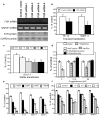Inhibition of farnesoid X receptor controls esophageal cancer cell growth in vitro and in nude mouse xenografts
- PMID: 23280144
- PMCID: PMC3604152
- DOI: 10.1002/cncr.27910
Inhibition of farnesoid X receptor controls esophageal cancer cell growth in vitro and in nude mouse xenografts
Abstract
Background: Gastroesophageal reflux is a risk factor for esophageal adenocarcinoma, and bile acid and its farnesoid X receptor (FXR) have been implicated in esophageal tumorigenesis. The authors investigated the role of FXR expression and activity in esophageal cancer initiation and growth.
Methods: FXR expression in esophageal adenocarcinoma tissues was assessed by immunohistochemistry. Knockdown of FXR expression in esophageal cancer cells in vitro and in nude mice xenografts was suppressed by FXR small hairpin RNA (shRNA) and guggulsterone (a natural FXR inhibitor). Esophageal cancer cells were treated with bile acids to demonstrate their effects on growth-promoting genes.
Results: FXR was expressed in 48 of 59 esophageal adenocarcinoma tissues (81.3%), and this overexpression was associated with higher tumor grade, larger tumor size, and lymph node metastasis; however, was inversely associated with retinoic acid receptor-β2 (RAR-β2 ) expression. Knockdown of FXR expression suppressed tumor cell growth in vitro and in nude mouse xenografts. Guggulsterone reduced the viability of esophageal cancer cells in a time-dependent and dose-dependent manner, whereas this effect was diminished after knockdown of FXR expression. Guggulsterone induced apoptosis through activation of caspase-8, caspase-9, and caspase-3 in tumor cells. FXR mediated bile acid-induced alterations of gene expression, eg, RAR-β2 and cyclooxygenase-2 (COX-2).
Conclusions: Inhibition of FXR by FXR shRNA or guggulsterone suppressed tumor cell viability and induced apoptosis in vitro, and it reduced tumor formation and growth in nude mouse xenografts. FXR also mediated bile acid-induced alterations of cell growth-related genes in esophageal cancer cells.
Copyright © 2012 American Cancer Society.
Conflict of interest statement
The authors have declared no competing interests.
Figures





References
-
- Blot W. Esophageal cancer trends and risk factors. Semin Oncol. 1994;21:403–410. - PubMed
-
- Spechler SJ. Barrett’s esophagus: a molecular perspective. Curr Gastroenterol Rep. 2005;7:177–181. - PubMed
-
- Chen X, Yang CS. Esophageal adenocarcinoma: a review and perspectives on the mechanism of carcinogenesis and chemoprevention. Carcinogenesis. 2001;22:1119–1129. - PubMed
-
- Barak N, Ehrenpreis ED, Harrison JR, Sitrin MD. Gastro-oesophageal reflux disease in obesity: pathophysiological and therapeutic considerations. Obes Rev. 2002;3:9–15. - PubMed
-
- Makishima M, Okamoto AY, Repa JJ, et al. Identification of a nuclear receptor for bile acids. Science. 1999;284:1362–1625. - PubMed
Publication types
MeSH terms
Substances
Grants and funding
LinkOut - more resources
Full Text Sources
Medical
Research Materials

